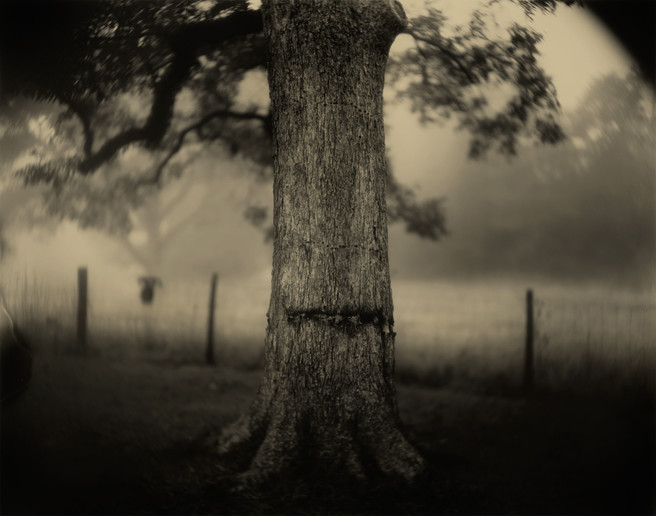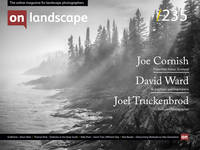Sally Mann

Thomas Peck
The real pleasure of photography is that it forces me to slow down and really look. That’s never easy in our rushed world, so a chance to stop, look and see is truly valuable.
The camera is a recording tool: mechanical, technical, objectifying. The photographer is a subjective cypher: selecting, emphasising, interpreting. The bringing together of these antithetical poles can lead to an artistic fusion that is evocative and profound. Even more so when the photographs that result move from the literal to metaphor. The history of photography in the 20th Century increasingly evolved away from the representation of an objective reality (think of Weston, Steichen and Ansel Adams, straight photography and the f64 group) towards the expression of subjective states of feeling (Sugimoto, Burtynsky, Kenna). And that focus on emotion is what we see when we look at Sally Mann’s photographs from the southern states of the US in the 1990s.
What do we see when we look at this picture? A vertical tree trunk placed centrally in the frame. At roughly chest height is a scar, a scorch mark in the bark of the tree. The foreground is dark, gloomy. The background is lighter, but is blurry, out of focus. It is misty, opaque, and difficult to penetrate visually. We sense a field behind a fence with more trees in the background. Pinned on the fence is a dark patch, it looks faintly human in form, a body, two arms, but it is too small to be a real figure…, an article of clothing perhaps? Or is the figure behind the fence, a scarecrow?
The power of this photograph, however, comes to us when we consider the image metaphorically. Trees themselves are of course redolent with meaning. They are archetypes with (real and allegorical) roots deep in local cultures. In Germany for example, the linden tree symbolises peace, truth and justice. In mythology it is associated with Freya, motherly goddess of truth and love. Consequently, Germans often met under the tree to hold their justice cases and marriage ceremonies. The cherry tree and its blossom are symbolic of the fleetingness of life and a sense of renewal. The Japanese like to remind themselves of this and party with colleagues, friends and families under the falling cherry blossom in May. In the UK we have the oak, symbol of strength and survival, it has become our national tree.

Sally Mann
Deep South, Untitled (Scarred Tree), 1998
Tea-toned gelatin silver print
40 x 50 inches
101.6 x 127 cm
@ Sally Mann. Courtesy Gagosian
The tree in Mann’s photograph is also geographically located in the deep southern states of the US. Here, trees perhaps have a unique, historical resonance, wrapped up with the difficult history of slavery that casts its shadow through the centuries to the modern day. “Southern trees bear a strange fruit/ Blood on the leaves and blood at the root” sang Billie Holiday. And Mann’s tree is scarred, torn, violated. The rupture in the bark is a wound. It has festered, calcified into the tree. The tree grows on, the wound remains, visible and not yet truly healed. It represents a terrible history of this locality which has yet to be fully absorbed and absolved.
That physical scar is the most obvious element that demands interpretation from the viewer. However, the whole mood of the image is imbued with a darkness, brooding and menace that back it up. Mann uses a large format camera with an antique lens, hence the fogginess and the heavy vignetting. The result becomes hugely evocative. In this case a dreamlike, or perhaps it might be better to say a ‘nightmare-like’, state. Certainly, there is a melancholy to the image, a sadness, regret, even a sense of guilt. But there, right with that last phrase, I have, of course, jumped from literal reading of the image, to metaphorical interpretation. Is that fair? How do I know that this is what is meant by the photographer? The viewer can never know of course, only wonder. Having said that, I must admit I’ve just finished reading Mann’s memoir with photographs, Hold Still, which, in part, deals with her own realisation and exploration of the history of slavery in the land in which she grew up and lives. Mann quotes from Faulkner’s The Bear: “Don’t you see? This whole land, the whole South is cursed, and all of us who derive from it, whom it ever suckled, white and black both, lie under the curse”.
It’s a truism to state that art inevitably always circles back to deal with the personal sensibility of the artist. But for the viewer that’s what makes it so fascinating; to see, and feel, through another’s eyes. From a UK point of view, to peer through the vision of an artist from the southern states of America, takes us on an unsettling, intuitive and hugely moving journey through a storied landscape.
For more of Sally Mann’s images please see www.sallymann.com
I highly recommend Hold Still. A memoir with photographs, by Sally Mann, pub: Bay Back Books, 2015. A fascinating read full of insight into the creative process of a wonderful photographic artist combined with an honest, candid investigation into her family past.

